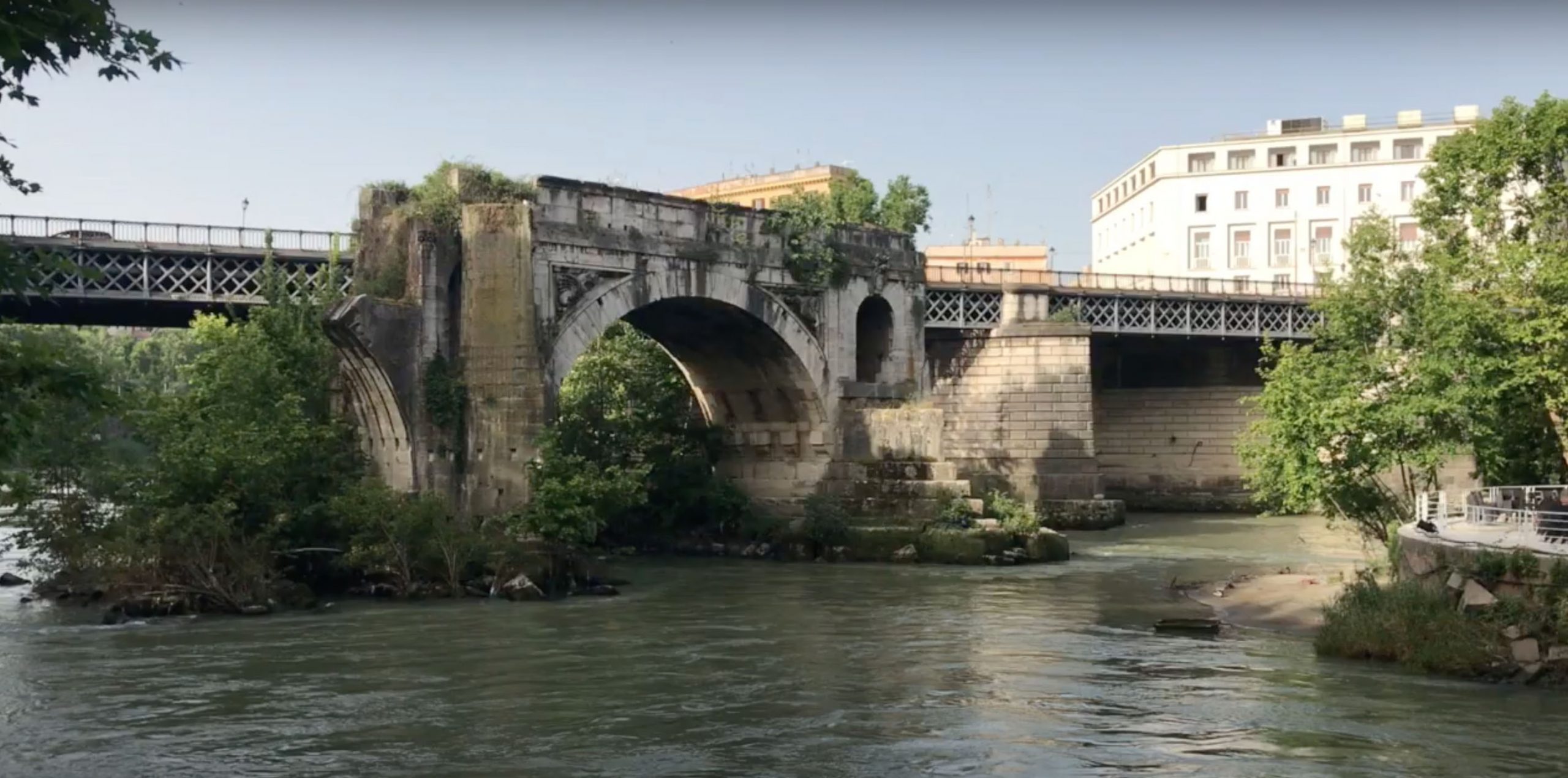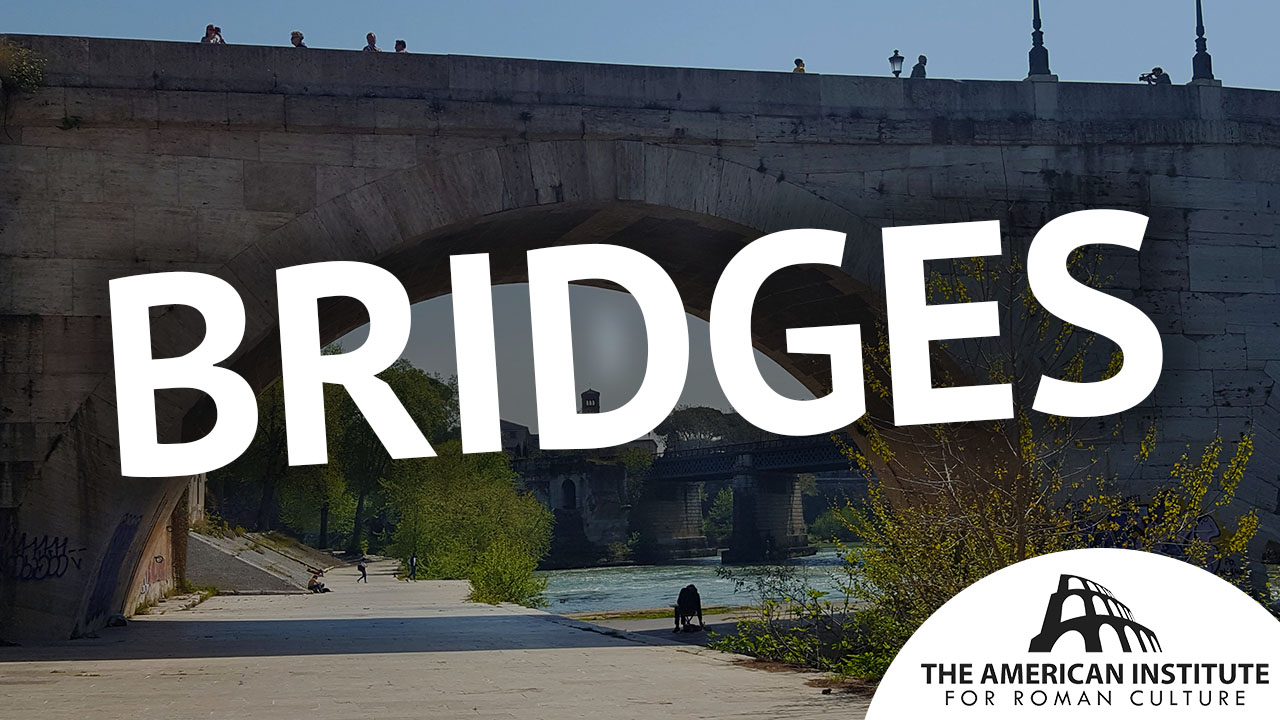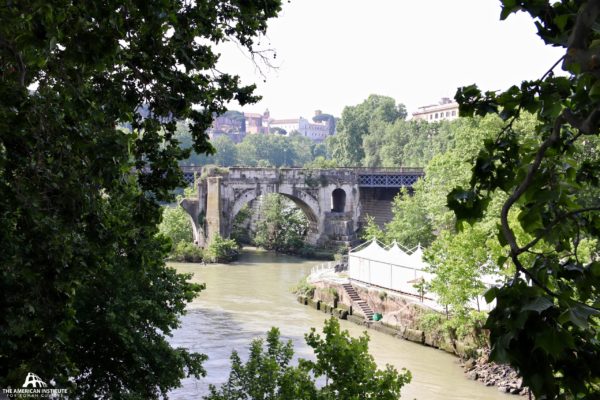Pons/Ponte Rotto or broken bridge is the common name applied to the Augustan – era Pons Aemilius. This was the major bridge connecting Trastevere to the Forum Boarium. It broke in the middle ages, though three arches withstood, ultimately torn down with the construction of the 19C flood walls. It is an impressive single arcade that reminds us of the great skill in bridge making that the Romans possessed.
PONS AEMILIUS, the official name (hemerol. Amit. Vail. Allif. ad Kal. Sept., CIL i². pp. 217, 240, 244; Not. app.; Pol. Silv. 545; Hist. Aug. Elag. 17) of the first stone bridge across the Tiber, said to have been built ,ὑπ̓ Αἰμιλίου ταμιεύοντος (Plut. Numa 9). A comparison of the citations just made with other passages (Ov. Fast. vi. 477-478; Serv. Aen. viii. 646; Aethicus, Cosmog. 28 (ed. Riese 83) ) indicates that this bridge was close to the pons Sublicius and crossed the river from the forum Boarium (cf. CIL i². p. 325).
Read more:
According to Livy (xl. 51. 4) M. Fulvius Nobilior when censor in 179 B.C. contracted (undoubtedly with his colleague M. Aemilius Lepidus) for the placing of ‘pilas pontis in Tiberi,’ and P. Scipio Africanus and L. Minucius, the censors of 142 B.C., built arches (fornices) on these piers. This statement is now generally believed to refer to the pons Aemilius, and Plutarch’s attribution of the building of the bridge to a quaestor, Aemilius, is interpreted as a mistake or on the hypothesis that the fornices of 142 were of wood and that the stone arches were laid by a later Aemilius in his quaestorship. That the upper part of the bridge was of wood, until 142 at least, is certain, and therefore a statement in Obsequens (16) under date of 156 B.C., pontis maximi tectum cum columnis in Tiberim deiectum, is cited as evidence that pons maximus was then a name in common use, although Mommsen’s conjecture pontificis may be correct.
In the fourteenth century an arch was standing in the forum Boarium in front of the Ponte Rotto described as arcus marmoreus in platea pontis S. Mariae (Anon. Magl. 155), on which was an inscription (CIL vi. 878) referring to a restoration by Augustus after 12 B.C. It is possible that this restoration may have been that of the bridge. Besides pons S. Mariae (LS ii. 22-28; iv. 49, 84) this bridge was called in the Middle Ages pons Senatorum (Mirab. II), and pons Maior (Eins. 7. 4; cf. Delbruck, Hellenistische Bauten i. 14). In the seventh century Aethicus (loc. cit.) writes: pontem Lepidi qui nunc abusive a plebelapideus dicitur iuxta forum boarium transiens. Both these early variants of Aemilius are easily explained, Lepidi from Aemilius, and lapideus from the tradition that it was the first stone bridge (Plut. loc. cit.). The identification of the pons Aemilius of the empire with the present Ponte Rotto may be regarded as certain. This bridge was partially destroyed by the flood of 1557 (cf. M61. 1906, 189-193) and repaired by Gregory XIII (III. 37). In 1598 the eastern half was carried away, and in 1887 two of the three remaining arches were removed, so that only one now stands in midstream. Recent investigation has shown that the ancient pier of this arch is not the earliest, as the remains of the abutment are earlier and belong to a bridge slightly further north which crossed the river at a slightly different angle. This was therefore the bridge of the second century B.C. and the existing arch and pier belong to a second structure, probably that of Augustus (Delbrfick, op. cit. i. 12-22 ; ii. taf. 2 ; Richter, Befestigung d. Ianiculums 18-20; Jord. i. I. 409-414; 420-421; RE i. 593; M61. 1906, 180-181, 189-193 ; Gilb. iii. 257-260 ; Ber. d. sachs. Gesell. 1850, 320-326; Besnier 128-130; BC 1914, 390; DuP 58, and fig. 31; TF 139-141). Cf. Ill. 32: and see FORNIX AUGUSTI.
For a viaduct on the road leading from the bridge to the Janiculum, cf. VIA AURELIA.
Explore further:
This content is brought to you by The American Institute for Roman Culture, a 501(C)3 US Non-Profit Organization.
Please support our mission to aid learning and understanding of ancient Rome through free-to-access content by donating today.
Cite This Page
Cite this page as: Darius Arya, The American Institute for Roman Culture, “Pons Aemilius (Ponte Rotto)” Ancient Rome Live. Last modified 06/30/2020. https://ancientromelive.org/pons-rotto/
License
Created by The American Institute of Roman Culture, published on 10/24/2019 under the following license: Creative Commons: Attribution-NonCommercial-ShareAlike. This license lets others remix, tweak, and build upon this content non-commercially, as long as they credit the author and license their new creations under the identical terms. Please note that content linked from this page may have different licensing terms.






